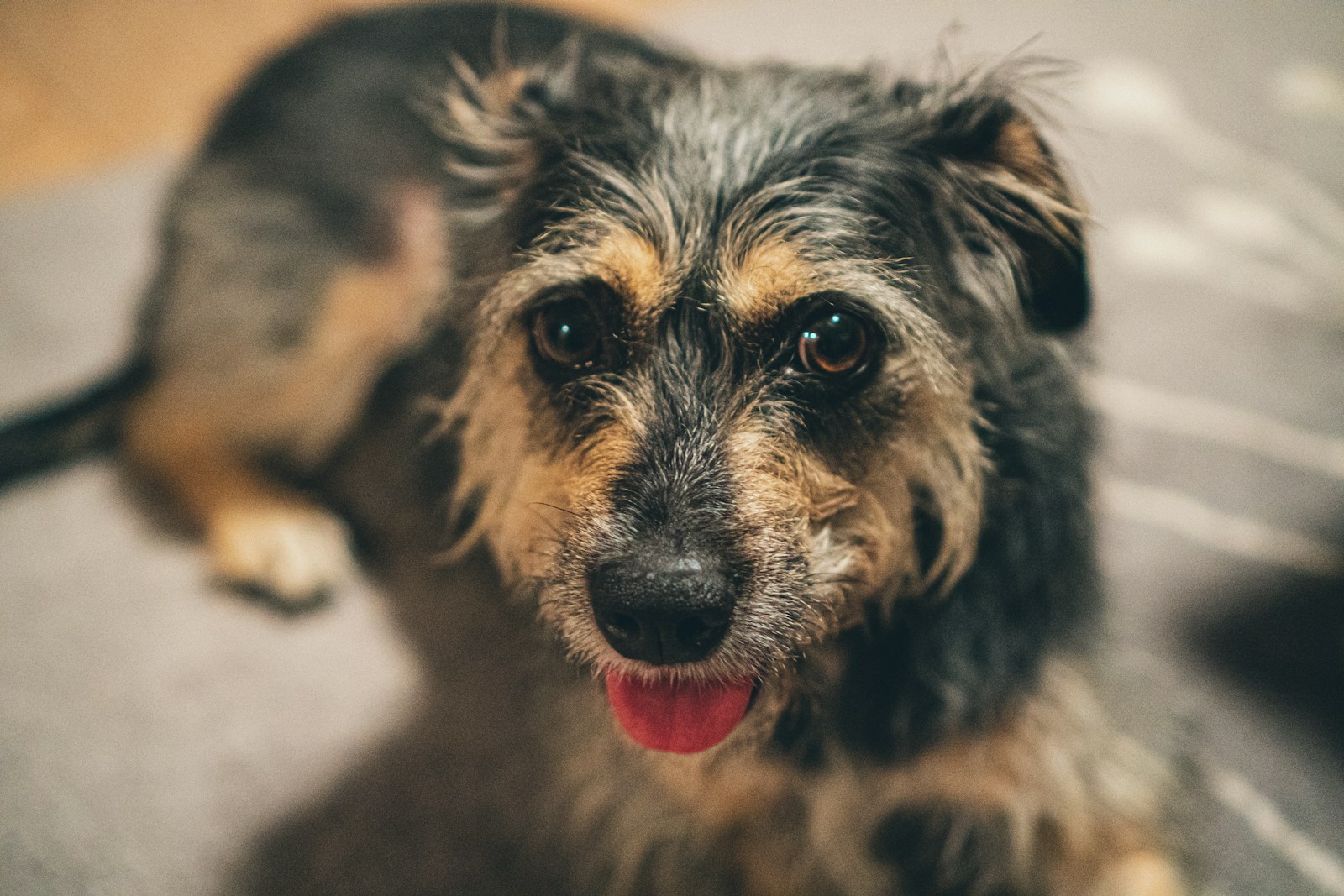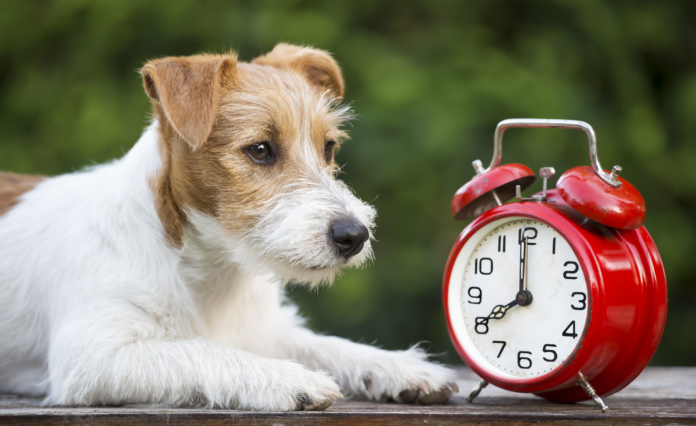Understanding your dog’s biological clock
DogTime‘s article on How Daylight Savings Time Affects Your Dog sheds light on the impact of time changes on our furry friends. For humans, the extra hour is a great way to catch up on sleep. But for dogs, the effects can be very different.
Animals don’t set their routines by the clock that we use as humans to keep on schedule. They have their own circadian rhythm — a biological clock that helps them know when to eat, sleep, go potty, and do everything else in their day.
So when humans change the clock for the end of Daylight Saving Time, it can affect dogs more strongly. Here are a few ways your dog might struggle during this time and what you can do to help them adjust.
Potty time adjustments
Many dogs need to go outside for a potty break first thing in the morning.
When you sleep in for an extra hour, your pup might be confused and sit next to your bed waiting for you to put on your slippers and grab the leash. If you ignore their pleas, they might not be able to hold it in. An unfortunate spot like your plant or rug might become their new morning business area.
Most pooches stick to regular potty times throughout the day, so it will take some time before they can adjust. A good idea is to slowly shift their potty time over the course of a week. Gradually move their first outing a few minutes later each day until it aligns with the new time change.
“Patience is key when helping your dog adjust to new routines,” says Dr. Jenna Olson, a veterinarian with over 10 years of experience.
Another helpful tip is to offer reassurance and positive reinforcement. Reward your pup with praise or a treat when they adapt well to the new schedule. This can make the transition smoother and more pleasant for both of you.
Feeding time management
Many dogs are creatures of habit, especially when it comes to their meal times. Just like you expect lunch at noon, your furry friend expects food at their usual hour. When Daylight Saving Time ends, suddenly, that hour shifts, and your dog may feel quite out of sorts.
Imagine your dog sitting by their bowl, glancing up at you with those big, round eyes. They might whimper or bark, trying to remind you it’s feeding time, even though the clock says otherwise. If their meals are delayed, you may notice some distinct changes in their behavior.
First, your dog might become more insistent and may beg more frequently. When their begging doesn’t yield food, they could turn to other means to satisfy their hunger, such as chewing on furniture or raiding trash cans. All these actions are their ways of expressing that something in their routine feels off.
Consider this scenario: You’ve come home late from a long day at work. Your pup is not only hungry but also confused and anxious. Understanding their disappointment can help you devise a plan to smooth out the transition.
An effective strategy involves adjusting their feeding schedule gradually before the time change. Start by shifting their meals by a few minutes each day (10-15 minutes is a good range) leading up to the end of Daylight Saving Time. This can help them adapt more seamlessly without causing stress or discomfort.
Here’s a simple table to help you plan the gradual time shift for their meals:
| Day | Meal Time Adjustment |
| Day 1 | 10 minutes later |
| Day 2 | 20 minutes later |
| Day 3 | 30 minutes later |
| Day 4 | 40 minutes later |
| Day 5 | 50 minutes later |
| Day 6 | 60 minutes later |
By following this incremental approach, your dog will likely find it easier to adjust their internal clock to match the new schedule. Remember, patience is essential during this time. Your understanding and support can make a significant difference in easing their transition.
This adjustment period offers an excellent opportunity to reflect on the wonders of animal behavior. How do dogs so precisely know their feeding time? Is it their keen sense of time or merely their reliance on consistent daily patterns? Exploring these questions can deepen your connection and appreciation for your furry companions. What other fascinating insights about your dog’s behavior can you discover during this time of change?
Embrace this curiosity and take the time to observe and learn. The more you understand about your dog’s needs and behaviors, the better equipped you’ll be to support them in various situations, including temporal shifts like the end of Daylight Saving Time.
Coping with separation anxiety
Coping with separation anxiety during the transition of Daylight Saving Time can be challenging for both dogs and their owners. Dogs are known for their loyalty and attachment to their human families. When the routine changes, such as you arriving home an hour later due to the time change, this can lead to increased feelings of loneliness and confusion in your pet.
Your dog may begin to exhibit signs of separation anxiety, which can include behaviors such as whining, pacing, barking excessively, or even more destructive actions like chewing furniture or digging at doors. The internal clock of your dog is disrupted, and they may struggle to understand why you’re not home when they expect you to be.
To help your dog handle this transition more smoothly, consider incorporating some strategies to reduce their anxiety. Start by ensuring your dog gets plenty of exercise before you leave for the day. A well-exercised dog is typically more calm and less likely to feel stressed when left alone.
Additionally, create a comfortable and safe environment for your dog while you’re away. This can include providing them with their favorite toys, blankets that smell like you, or interactive puzzle toys that can keep them occupied and mentally stimulated. Leaving a piece of clothing with your scent can be comforting as well.
Another helpful approach is to use calming aids, such as pheromone diffusers, which can have a soothing effect on your dog. These products mimic the natural calming pheromones produced by dogs, helping to create a sense of security and calmness.
Gradually practicing short departures can also be effective. Start by leaving your dog alone for short periods and then gradually increase the duration. This helps your dog to slowly get used to the idea of being alone and understand that you’ll return.
Consistency in your schedule can go a long way. Even with the time change, try to keep other elements of your dog’s routine as consistent as possible. Feed them at the same times, take them for walks at the same intervals, and provide them with affection and attention when you are home.
Finally, if your dog seems particularly distressed or if their anxiety behaviors become unmanageable, consulting a veterinarian or a professional dog behaviorist can provide additional guidance tailored to your dog’s specific needs. These professionals can offer more specialized strategies and possibly recommend treatment options that may help reduce your dog’s anxiety.
Caring for a dog experiencing separation anxiety requires patience and understanding. By taking proactive steps to manage their anxiety, you can ensure that the end of Daylight Saving Time is a smooth transition not only for you but also for your beloved canine companion.
Steps to help your dog adjust
The shift from Daylight Saving Time can be a bit bumpy for your furry friend, but there are several proactive steps you can take to ease the transition. By following a few simple strategies, you can help your dog adapt to the new schedule smoothly.
- Gradual Adjustments: In the weeks leading up to the time change, gradually adjust your dog’s schedule by small increments. Move feeding, potty, and walk times by 10-15 minutes every few days. This slow progression helps them align their internal clock without causing too much stress.
- Maintain Consistency: Consistency is key. Stick to a set routine even after Daylight Saving Time ends. Dogs thrive on predictable schedules, so keep feeding, walking, and play times regular.
- Provide Comfort and Reassurance: Offer extra comfort and positive reinforcement during this period. Praise your dog when they adapt well to the new times, and provide treats and extra affection for good behavior.
- Exercise and Mental Stimulation: Ensure your dog gets plenty of physical and mental exercise each day. A well-exercised dog is less likely to experience anxiety and more likely to adjust calmly to the new schedule.
- Create a Relaxing Environment: Create a comfortable and safe environment for your dog to relax in while you’re away. Leave some of their favorite toys, a cozy blanket, and maybe even a piece of your clothing with your scent on it to comfort them.
- Use Calming Aids: Consider using calming aids like pheromone diffusers or calming music to help reduce anxiety. These can provide a soothing environment, making the transition easier for your dog.
For more tips on helping your dog adjust to the end of Daylight Saving Time, you can read more about this at DogTime. By taking these steps, you can ensure a smoother transition and help your dog navigate the changes without stress. Patience and understanding go a long way in making adjustments easier for both you and your furry companion.

